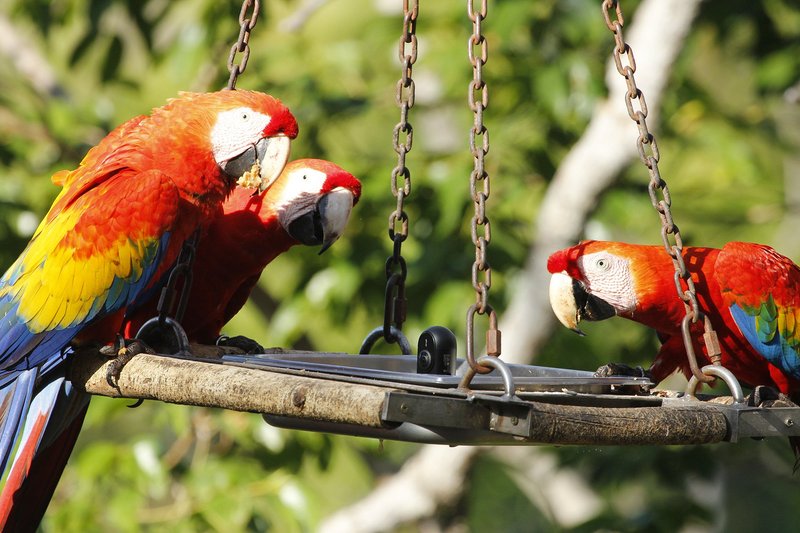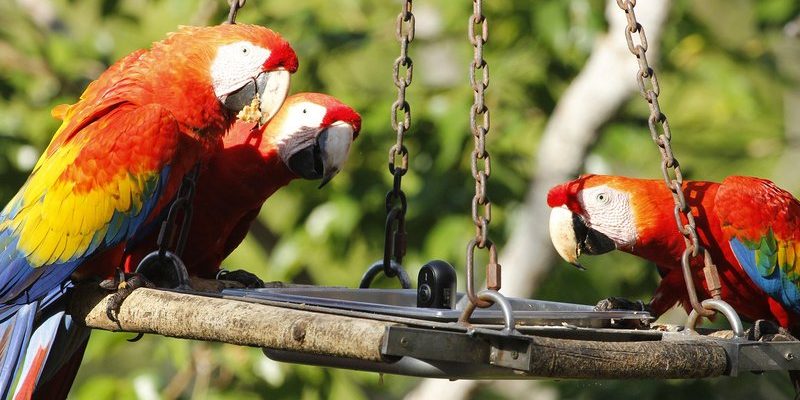
Imagine being in a dense rainforest, surrounded by towering trees and the sounds of nature all around you. Macaws flourish in such environments, but their survival isn’t purely luck. Instead, they’ve developed incredible skills and traits that allow them to thrive where they are. It’s a bit like wearing the right shoes for hiking—without them, you’d struggle to keep up with the rugged terrain. So, how do these beautiful birds manage to live in such dynamic and sometimes harsh habitats? Let’s explore.
Physical Adaptations
One of the first things you’ll notice about macaws is their stunning plumage. Their bright colors aren’t just for show; they play a significant role in their survival. The bold hues help them blend into the vibrant, sun-dappled canopies of tropical forests. Here’s the thing: when a bird can camouflage itself among leaves, it’s less likely to be spotted by predators. It’s nature’s way of providing a shield against danger.
Moreover, macaws have strong, curved beaks designed for cracking open tough nuts and seeds. These powerful beaks act like nature’s toolbox. With them, they can access a variety of food sources that other birds might struggle with. In a way, it’s similar to how we might use a special tool to fix something around the house. If you’ve ever tried to open a stubborn jar, you know the right tool makes all the difference.
Their feet are equally impressive. Macaws have zygodactyl feet, which mean they have two toes facing forward and two backward. This unique arrangement allows them to grip branches securely as they navigate their arboreal homes. Think of it like having the best grip shoes for climbing—every step becomes easier and more efficient.
Behavioral Adaptations
Beyond their physical traits, macaws exhibit fascinating behaviors that help them thrive. For example, they are incredibly social birds. Living in flocks not only enhances their ability to find food but also provides safety in numbers. When they travel together, they can keep an eye out for potential threats. It’s much like how friends look out for each other at a party, making sure no one gets into trouble.
Additionally, macaws are known for their problem-solving skills. Imagine being stuck with a tricky puzzle. Instead of giving up, you’d try different approaches until something clicks. Macaws do the same when it comes to finding food. They often use their intelligence to figure out the best ways to access hard-to-reach treats. Whether it’s a clever maneuver to get to a hidden nut or using their beaks to manipulate objects, these birds showcase a level of cunning that’s impressive.
Another interesting behavior is their vocal communication. Macaws use various calls to communicate with each other, from warning of danger to signaling food availability. Their loud squawks may seem jarring to us, but in the lush forests, it’s an essential part of their social structure.
Feeding Adaptations
Let’s talk food! Macaws primarily thrive on a diet of fruits, nuts, and seeds, but it’s a bit more complex than just munching away. Their strong beaks allow them to crack open the hard shells of nuts, which many other animals can’t manage. This gives them access to a rich food source with little competition.
You might be wondering, “What about the seasonal changes?” Macaws adapt their feeding habits based on the availability of food. During certain times of the year, when fruits are ripe and plentiful, they focus on that. But as seasons shift, they’ll switch to nuts or seeds, showing their flexibility and resilience. It’s much like how we adapt our meals with seasonal ingredients—we might enjoy fresh berries in the summer and hearty squash in the winter!
Furthermore, social feeding is a common practice among macaws. They often forage together, sharing information about where the best food can be found. It’s like when you and your friends share restaurant recommendations—you all get to enjoy a wider variety of options and make the experience more fun!
Habitat Adaptations
Macaws are found in diverse habitats, from rainforests to savannas. Their adaptability means they can thrive in different environments. For example, some species prefer the thick cover of the rainforest, while others are comfortable in open areas with fewer trees. This flexibility allows them to move to places with better resources when needed.
In areas where deforestation is rampant, some macaw populations have even started to adapt to urban settings. They’ve been spotted in parks and gardens, showing just how resourceful they can be. Just like us, who might navigate a new neighborhood to find our favorite coffee spot, macaws find ways to adapt to human-modified landscapes.
Macaws also build their nests high up in tree hollows, which helps protect their young from predators. These nesting habits are crucial for their survival, as it provides a safe space for raising their chicks. Just picture how every parent looks for a safe environment to raise their kids—it’s all about ensuring the next generation thrives.
Conservation Efforts and Their Importance
As we explore how macaws adapt to their environment, it’s crucial to highlight that many species are facing threats from habitat loss and poaching. Conservation efforts are vital in ensuring that these beautiful birds continue to thrive. Organizations are working tirelessly to protect their habitats, rehabilitate injured birds, and educate people about the importance of preserving these magnificent creatures.
You might think, “What can I do to help?” Supporting conservation efforts by donating to wildlife organizations or spreading awareness can make a significant difference. It’s like cheering on a team from the sidelines—you might not be on the field, but your support counts!
Another way to contribute is by fostering responsible pet ownership. Macaws are often captured and sold as pets, leading to population declines in the wild. By raising awareness about the importance of adopting rather than buying, we can help reduce the demand for wild-caught birds.
The Role of Macaws in Their Ecosystem
Macaws play a crucial role in their ecosystems, and their adaptations help maintain the health of their habitats. As they feed on fruits and nuts, they contribute to seed dispersal. When they eat, they often drop seeds throughout the forest, helping new plants grow. It’s like planting little trees everywhere they go!
Their need for certain types of trees for nesting and feeding also supports those species. By relying on particular plants, they help maintain the balance in their ecosystem, ensuring that their environment thrives. Just think of it as a chain reaction—when one part is taken care of, the whole system benefits.
In a more extensive sense, the presence of macaws can indicate the health of the surrounding environment. Healthy macaw populations often suggest a stable ecosystem, and their decline can serve as an early warning for ecological problems.
Macaws truly embody the art of adaptation. From their striking physical traits to their social behaviors and feeding strategies, these birds demonstrate resilience in the face of change. As we’ve discussed, their ability to adjust to different environments and challenges ensures their survival in an ever-changing world.
By understanding how macaws adapt, we not only strengthen our appreciation for these beautiful creatures but also recognize the importance of protecting their habitats. We all have a role to play in conservation, and every little effort counts. So, the next time you hear a macaw’s call or see one soaring through the sky, remember the incredible journey that led to their mastery of adaptation.

